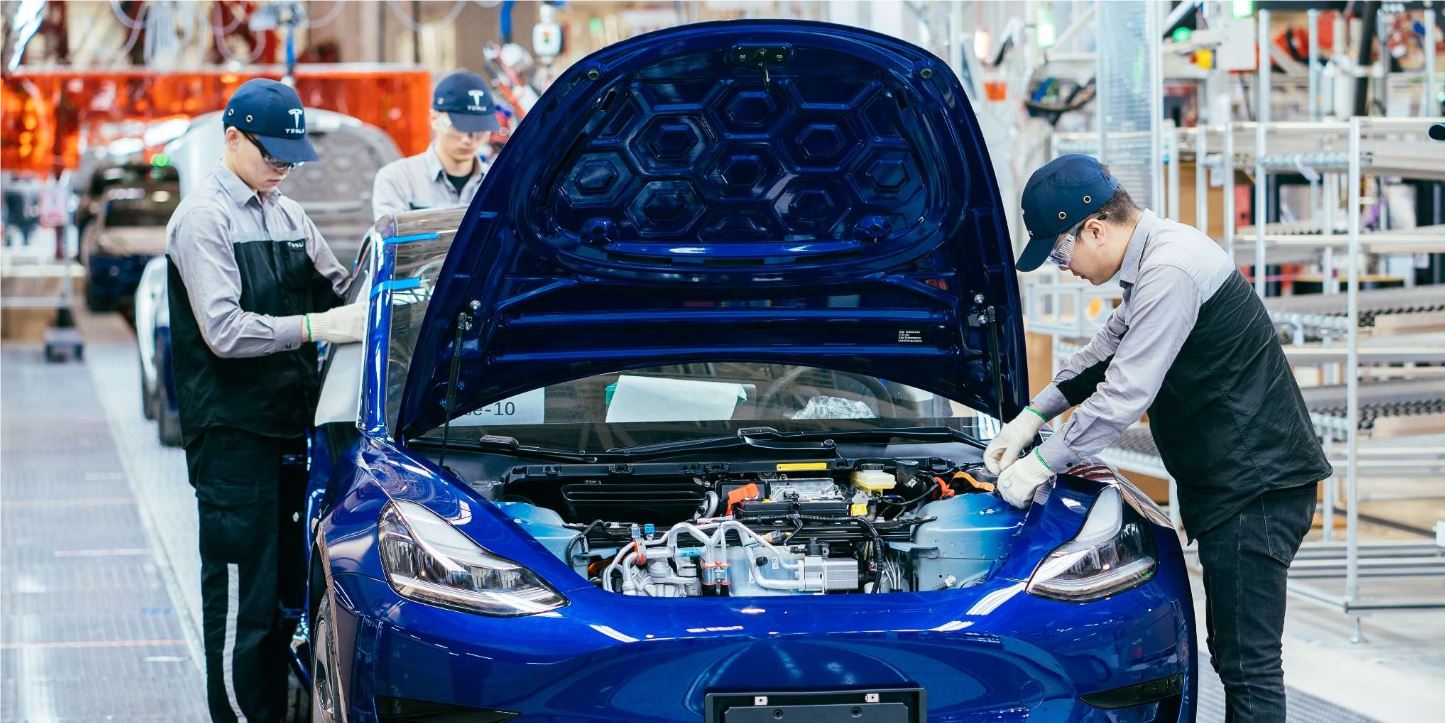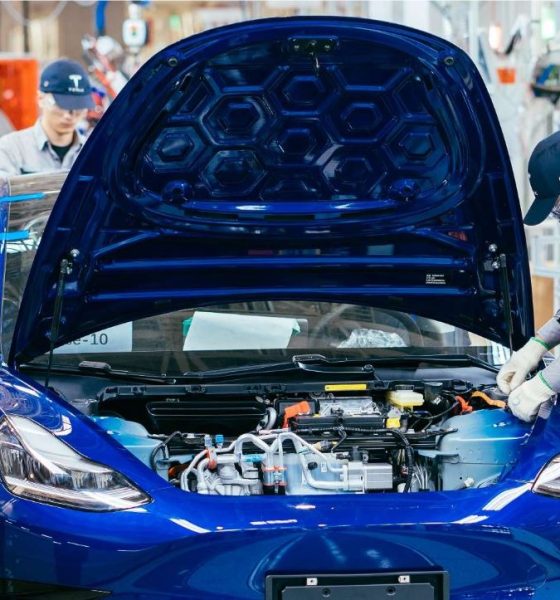

News
Tesla won’t be shipping cars from Shanghai to India: Transport Minister
Tesla will not be shipping its electric vehicles made at Gigafactory Shanghai in China to India, the country’s Transport Minister, Nitin Gadkari, reiterated during a government conference on Tuesday.
Gadkari is only repeating what he said in late 2021 as Tesla continued to negotiate with Indian politicians on terms that would allow the electric automaker to test demand in the country before committing to build a production facility there. However, Tesla wants to test demand by importing vehicles that it builds in other countries: most likely from Gigafactory Shanghai in China or Gigafactory Berlin in Germany, which just opened in the first quarter.
India is unwilling to agree to those terms and has been trying to push for Tesla to consider committing to a new production facility in India. Tesla CEO Elon Musk said last year that it would test demand in the country through imports before committing to a facility, but Indian officials are unwilling to budge over a year after Tesla registered itself as a company with the country’s economic ministry.
Gadkari said at the conference on Tuesday, according to Reuters, “Making in China and selling here is not a good proposition.” It is essentially the same thing he said in late 2021 when he also denied any potential talks of Tesla shipping cars from China to India. “I have told Tesla that don’t sell electric cars in India, which your company has manufactured in China. You should manufacture electric cars in India and also export cars from India,” Gadkari told the Hindu Stan Times. “Whatever support you (Tesla) want, will be provided by our government.”
While Tesla and India have worked diligently to reach a deal that would allow the automaker to test demand through imports and India to have a firm commitment from Tesla to build a production facility there, relatively no progress has been made. India has a primary focus on boosting local manufacturing as a part of Prime Minister Narendra Nodi’s “Make in India” campaign, which was launched nearly eight years ago.
We reported in January that, although the Make In India program has been in effect for several years, it has not been overly successful. Within the first five years of the initiative, India’s manufacturing GDP was the lowest it had been in twenty years. It dropped 1.2% in the first five years following the launch of Make In India, although the growth rate of manufacturing globally increased 6.9% from 2014-15 to 2019-20. $27 billion has been set aside by India to make this program successful, and although Tesla’s vehicles have been the best-selling EVs globally, it is a massive gamble to think it would unequivocally be an identical situation in India just because the cars sell well elsewhere.
Tesla’s ‘challenges’ with India gov’t halt potential rescue of $27B manufacturing initiative
What the future holds for the Tesla-India partnership is up in the air. It seems that, until one side is willing to budge from their needs in the deal, talks will not advance. India has set aside too much money and too much time to increase domestic manufacturing efforts, and Tesla’s potential India Gigafactory will cost billions of dollars to build and billions more to operate, which is too much of a financial liability for the company to assume.
I’d love to hear from you! If you have any comments, concerns, or questions, please email me at joey@teslarati.com. You can also reach me on Twitter @KlenderJoey, or if you have news tips, you can email us at tips@teslarati.com.

News
Tesla FSD fleet is nearing 7 billion total miles, including 2.5 billion city miles
As can be seen on Tesla’s official FSD webpage, vehicles equipped with the system have now navigated over 6.99 billion miles.

Tesla’s Full Self-Driving (Supervised) fleet is closing in on almost 7 billion total miles driven, as per data posted by the company on its official FSD webpage.
These figures hint at the massive scale of data fueling Tesla’s rapid FSD improvements, which have been quite notable as of late.
FSD mileage milestones
As can be seen on Tesla’s official FSD webpage, vehicles equipped with the system have now navigated over 6.99 billion miles. Tesla owner and avid FSD tester Whole Mars Catalog also shared a screenshot indicating that from the nearly 7 billion miles traveled by the FSD fleet, more than 2.5 billion miles were driven inside cities.
City miles are particularly valuable for complex urban scenarios like unprotected turns, pedestrian interactions, and traffic lights. This is also the difference-maker for FSD, as only complex solutions, such as Waymo’s self-driving taxis, operate similarly on inner-city streets. And even then, incidents such as the San Francisco blackouts have proven challenging for sensor-rich vehicles like Waymos.
Tesla’s data edge
Tesla has a number of advantages in the autonomous vehicle sector, one of which is the size of its fleet and the number of vehicles training FSD on real-world roads. Tesla’s nearly 7 billion FSD miles then allow the company to roll out updates that make its vehicles behave like they are being driven by experienced drivers, even if they are operating on their own.
So notable are Tesla’s improvements to FSD that NVIDIA Director of Robotics Jim Fan, after experiencing FSD v14, noted that the system is the first AI that passes what he described as a “Physical Turing Test.”
“Despite knowing exactly how robot learning works, I still find it magical watching the steering wheel turn by itself. First it feels surreal, next it becomes routine. Then, like the smartphone, taking it away actively hurts. This is how humanity gets rewired and glued to god-like technologies,” Fan wrote in a post on X.
News
Tesla starts showing how FSD will change lives in Europe
Local officials tested the system on narrow country roads and were impressed by FSD’s smooth, human-like driving, with some calling the service a game-changer for everyday life in areas that are far from urban centers.

Tesla has launched Europe’s first public shuttle service using Full Self-Driving (Supervised) in the rural Eifelkreis Bitburg-Prüm region of Germany, demonstrating how the technology can restore independence and mobility for people who struggle with limited transport options.
Local officials tested the system on narrow country roads and were impressed by FSD’s smooth, human-like driving, with some calling the service a game-changer for everyday life in areas that are far from urban centers.
Officials see real impact on rural residents
Arzfeld Mayor Johannes Kuhl and District Administrator Andreas Kruppert personally tested the Tesla shuttle service. This allowed them to see just how well FSD navigated winding lanes and rural roads confidently. Kruppert said, “Autonomous driving sounds like science fiction to many, but we simply see here that it works totally well in rural regions too.” Kuhl, for his part, also noted that FSD “feels like a very experienced driver.”
The pilot complements the area’s “Citizen Bus” program, which provides on-demand rides for elderly residents who can no longer drive themselves. Tesla Europe shared a video of a demonstration of the service, highlighting how FSD gives people their freedom back, even in places where public transport is not as prevalent.
What the Ministry for Economic Affairs and Transport says
Rhineland-Palatinate’s Minister Daniela Schmitt supported the project, praising the collaboration that made this “first of its kind in Europe” possible. As per the ministry, the rural rollout for the service shows FSD’s potential beyond major cities, and it delivers tangible benefits like grocery runs, doctor visits, and social connections for isolated residents.
“Reliable and flexible mobility is especially vital in rural areas. With the launch of a shuttle service using self-driving vehicles (FSD supervised) by Tesla in the Eifelkreis Bitburg-Prüm, an innovative pilot project is now getting underway that complements local community bus services. It is the first project of its kind in Europe.
“The result is a real gain for rural mobility: greater accessibility, more flexibility and tangible benefits for everyday life. A strong signal for innovation, cooperation and future-oriented mobility beyond urban centers,” the ministry wrote in a LinkedIn post.
News
Tesla China quietly posts Robotaxi-related job listing
Tesla China is currently seeking a Low Voltage Electrical Engineer to work on circuit board design for the company’s autonomous vehicles.

Tesla has posted a new job listing in Shanghai explicitly tied to its Robotaxi program, fueling speculation that the company is preparing to launch its dedicated autonomous ride-hailing service in China.
As noted in the listing, Tesla China is currently seeking a Low Voltage Electrical Engineer to work on circuit board design for the company’s autonomous vehicles.
Robotaxi-specific role
The listing, which was shared on social media platform X by industry watcher @tslaming, suggested that Tesla China is looking to fill the role urgently. The job listing itself specifically mentions that the person hired for the role will be working on the Low Voltage Hardware team, which would design the circuit boards that would serve as the nervous system of the Robotaxi.
Key tasks for the role, as indicated in the job listing, include collaboration with PCB layout, firmware, mechanical, program management, and validation teams, among other responsibilities. The role is based in Shanghai.
China Robotaxi launch
China represents a massive potential market for robotaxis, with its dense urban centers and supportive policies in select cities. Tesla has limited permission to roll out FSD in the country, though despite this, its vehicles have been hailed as among the best in the market when it comes to autonomous features. So far, at least, it appears that China supports Tesla’s FSD and Robotaxi rollout.
This was hinted at in November, when Tesla brought the Cybercab to the 8th China International Import Expo (CIIE) in Shanghai, marking the first time that the autonomous two-seater was brought to the Asia-Pacific region. The vehicle, despite not having a release date in China, received a significant amount of interest among the event’s attendees.








